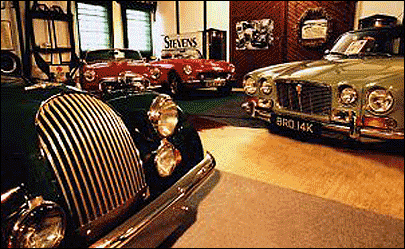A German vintage car specialist is using radio frequency identification technology to protect its vehicles from thieves and car lovers who may get a bit too excited about peeking under the hood of a 1964 Vanden Plas Princess. Stevens GmbH, which sells vintage cars and parts and accessories for them, hired German systems integrator ISIS IC to install an antitheft and anti-tamper system based on active RFID tags functioning at 868 MHz.
The system, called LogICware, was installed at the Stevens showroom in Wesel, near Duesseldorf, about a year ago. It comes with 20 active tags equipped with motion sensors built by ISIS IC from components provided by multiple vendors. Dirk Unsenos, CEO of ISIS IC, declines to offer any details regarding the component makers.
Applied to various car parts with a type of adhesive designed not to damage the vehicles, these tags are placed on mirrors, hubcaps and other small parts that could easily be stolen from the showrooms. In addition, they are applied to car doors and hoods. If someone opens a tagged door or moves a tagged part, the sensor on the tag detects the motion, causing the tag to transmit an alert to a fixed reader attached to a PC in the office. The computer than triggers an alarm. The system allows users to choose how they would prefer to be notified if a tag is moved: either via telephone, Short Message Service (SMS) or Multimedia Messaging Service (MMS). The software can be integrated into standard software packages from such firms as SAP and Oracle.
The tags, which must be within 100 meters of the reader, send signals every three seconds. Powered by a lithium-ion battery, each tag has a diameter of 40 millimeters and a thickness of 1 centimeter.
Hartmut Stevens, the owner of Stevens, refuses to reveal the volume of goods lost or damaged before LogICware was put in place, or the impact of deploying the system. The company had considered installing a Web camera or a video surveillance system, but decided against such systems because they would have had to be manually monitored. A typical electronic article surveillance (EAS) system used in a retail store would not have worked, because portal readers must be erected close to one another, and Stevens has wide doors for moving cars in and out. It would also have had to install multiple portal readers, Unsenos says, which would have been expensive. In addition, since the showroom is often not staffed, an alarm that sounded after a thief reached the exit doors would probably be too late to help the company avoid suffering a loss.
The software that runs the system can be used to deactivate tags, Unsenos says, identifying them by their unique ID numbers to accommodate rearrangements on the show room floor without setting off alarms.
The price of the system depends on the number of tags purchased. A 20-tag application, for instance, costs about $10,500. The system includes installation, an RFID interrogator, software and an alarm box.


